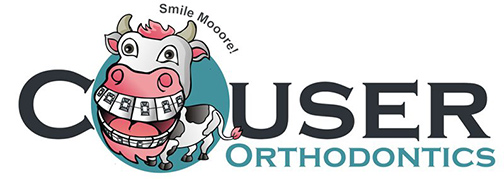
These days, it is common to see many younger patients with braces on both permanent and baby teeth. However, not all patients benefit from early interceptive treatment, or two-phase treatment, instead of the traditional orthodontic treatment approach. Appropriate orthodontic treatment is not a “one size fits all” approach. Each patient has unique needs and requires a customized treatment plan to achieve an ideal result. For this reason, the American Association of Orthodontists has educated the public for many years to seek an orthodontic evaluation no later than 7 years of age, or at the first recognition of the existence of an orthodontic problem.
By 7 years of age, most children have enough permanent teeth for Dr. Couser to determine whether an orthodontic problem exists or is developing. Ideally, Dr. Couser wants to see them when the permanent teeth are first erupting. When children are evaluated by Dr. Couser at this stage of dental development, they usually fall into one of three categories:
Category 1 – The teeth and jaws are developing normally, although tooth alignment may not be perfect. Dr. Couser may recommend periodic observation until the rest of the permanent teeth erupt to ensure that no other problems unexpectedly arise. Later, traditional comprehensive orthodontic treatment (full treatment) will be offered once the permanent teeth have erupted.
Category 2 – The teeth have mild-moderate esthetic problems, but the jaws are usually developing normally. Children in this category may have spacing or rotated teeth that are causing self consciousness or social anxiety. These children could wait for treatment from a traditional orthodontic perspective. However, their families are seeking early correction to relieve the self consciousness and social anxiety these problems have caused. Two-phase treatment may be offered by Dr. Couser as an option. This will require a second phase after the permanent teeth have erupted for a comprehensive result.
Category 3 – The teeth or jaws have moderate to severe problems. This may include crowding, ectopically positioned permanent teeth, unfavorable early loss of primary teeth, cross-bites, or underbites. In these cases, Dr. Couser may recommend early interceptive treatment or two-phase treatment at this age. Even though your child may have severe crowding or an overbite this does not mean that they will require early treatment. If there is a real benefit in doing early treatment then Dr Couser will recommend it. Usually after doing an early phase one treatment, a second phase or full treatment after the permanent teeth have erupted is required to straighten all the teeth.


